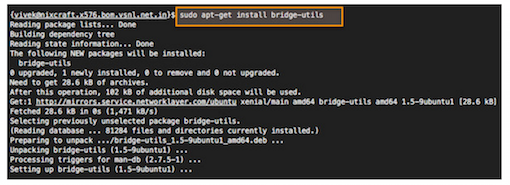How to set up a network bridge (br0) on Ubuntu Linux 14.04 and 16.04 LTS
This post will discuss how to set up a network bridge on a server running Ubuntu 14.04 LTS or 16.04 LTS.
A network bridge is nothing more than a simple technical method of connecting to an external network through a physical interface. This is useful when using LXC / KVM / Xen / Containers virtualization and other virtual interfaces. This tutorial will explain how you can configure a Linux bridge using bridge-utils (brctl) to a server with Ubuntu.
Network bridge example:
')

In this example, eth0 and eth1 are the physical network interface. eth0 is connected to the LAN and eth1 is connected directly to the provider equipment.
Enter the apt-get command to install bridge-utils:
or
Result:

Edit / etc / network / interfaces using a text editor such as nano, vi, or any other editor you like, and enter:
Next, install eth1 and mark it as br1, enter:
Set eth0 and mark it as br0, enter:
A note about br0 and DHCP
DHCP settings:
Save and close the file.
Restart server or network service
Now you need to restart the server or enter a command to restart the network service:
If you are using Ubuntu 14.04 LTS or an older version of the distribution, enter:
Command connectivity check
Use the ping / ip command to make sure the LAN and WAN interfaces are available:
Result:

You can now configure XEN / KVM / LXC containers to use br0 and br1 and access the Internet or an internal LAN directly. Thus, there is no need to install a special routing table or create iptables, SNAT rules.
Source: www.cyberciti.biz/faq/how-to-create-bridge-interface-ubuntu-linux
A network bridge is nothing more than a simple technical method of connecting to an external network through a physical interface. This is useful when using LXC / KVM / Xen / Containers virtualization and other virtual interfaces. This tutorial will explain how you can configure a Linux bridge using bridge-utils (brctl) to a server with Ubuntu.
Network bridge example:
')

In this example, eth0 and eth1 are the physical network interface. eth0 is connected to the LAN and eth1 is connected directly to the provider equipment.
Install bridge-utils
Enter the apt-get command to install bridge-utils:
$ sudo apt-get install bridge-utils or
$ sudo apt install bridge-utils Result:

Create a network bridge on a server with Ubuntu
Edit / etc / network / interfaces using a text editor such as nano, vi, or any other editor you like, and enter:
$ sudo cp /etc/network/interfaces /etc/network/interfaces.bakup-1-july-2016 $ sudo vi /etc/network/interfaces Next, install eth1 and mark it as br1, enter:
# br1 IPv4 , - auto br1 iface br1 inet static address 208.43.222.51 network 255.255.255.248 netmask 255.255.255.0 broadcast 208.43.222.55 gateway 208.43.222.49 bridge_ports eth1 bridge_stp off bridge_fd 0 bridge_maxwait 0 Set eth0 and mark it as br0, enter:
auto br0 iface br0 inet static address 10.18.44.26 netmask 255.255.255.192 broadcast 10.18.44.63 dns-nameservers 10.0.80.11 10.0.80.12 # set static route for LAN post-up route add -net 10.0.0.0 netmask 255.0.0.0 gw 10.18.44.1 post-up route add -net 161.26.0.0 netmask 255.255.0.0 gw 10.18.44.1 bridge_ports eth0 bridge_stp off bridge_fd 0 bridge_maxwait 0 A note about br0 and DHCP
DHCP settings:
auto br0 iface br0 inet dhcp bridge_ports eth0 bridge_stp off bridge_fd 0 bridge_maxwait 0 Save and close the file.
Restart server or network service
Now you need to restart the server or enter a command to restart the network service:
$ sudo systemctl restart networking If you are using Ubuntu 14.04 LTS or an older version of the distribution, enter:
$ sudo /etc/init.d/restart networking Command connectivity check
Use the ping / ip command to make sure the LAN and WAN interfaces are available:
# br0 br1 ip a show # ip r # ping -c 2 8.8.8.8 # ping -c 2 10.0.80.12 Result:

You can now configure XEN / KVM / LXC containers to use br0 and br1 and access the Internet or an internal LAN directly. Thus, there is no need to install a special routing table or create iptables, SNAT rules.
Source: www.cyberciti.biz/faq/how-to-create-bridge-interface-ubuntu-linux
Source: https://habr.com/ru/post/305184/
All Articles